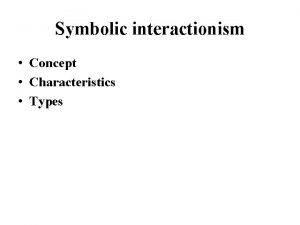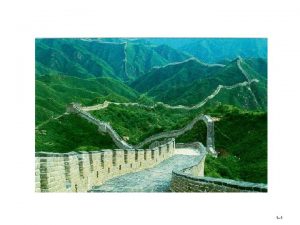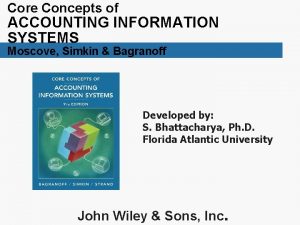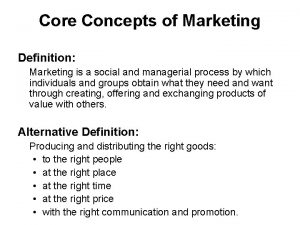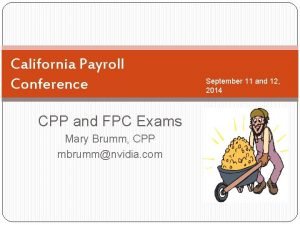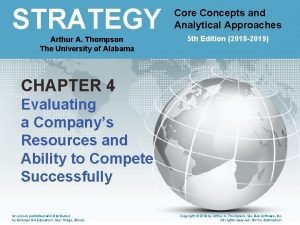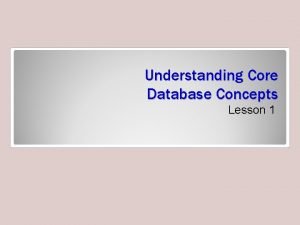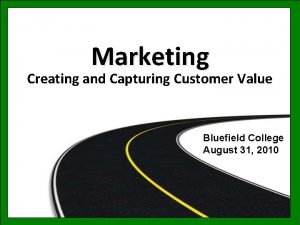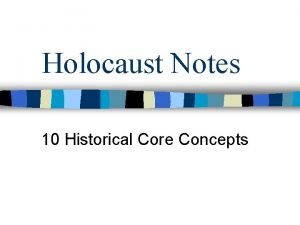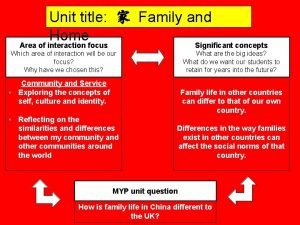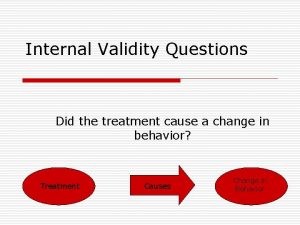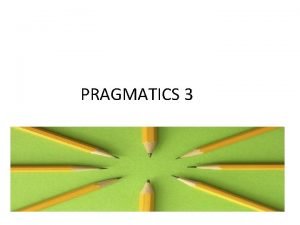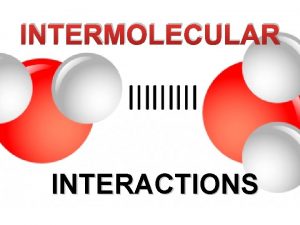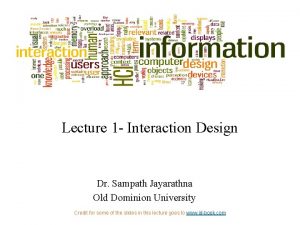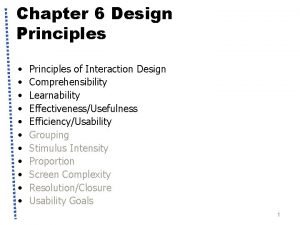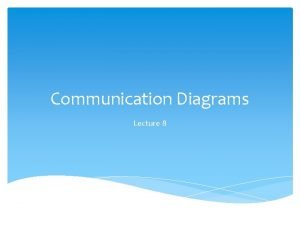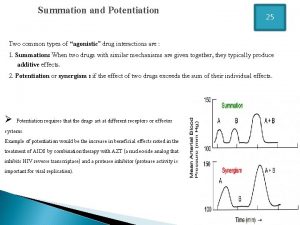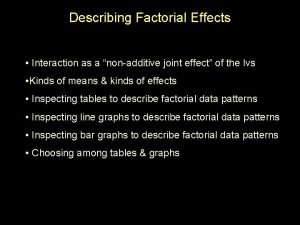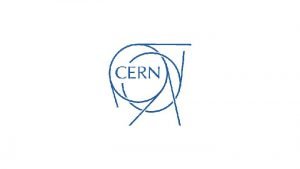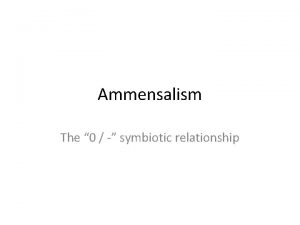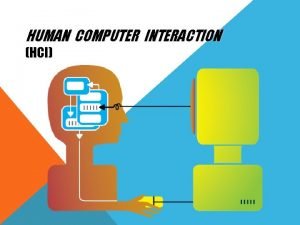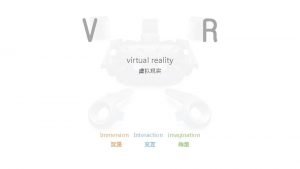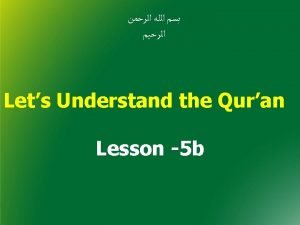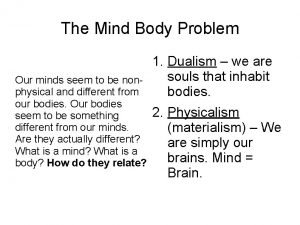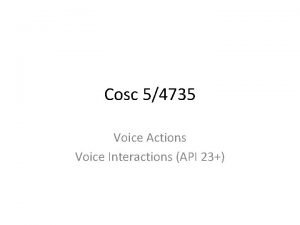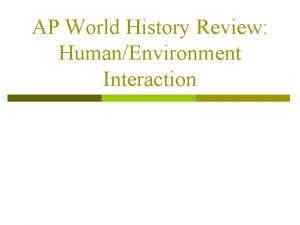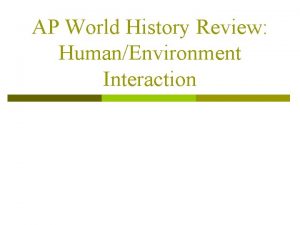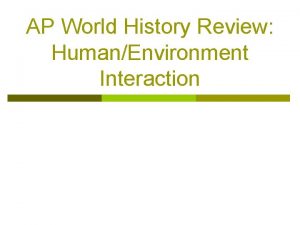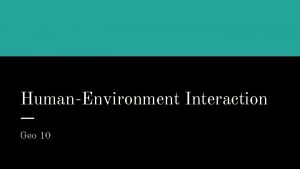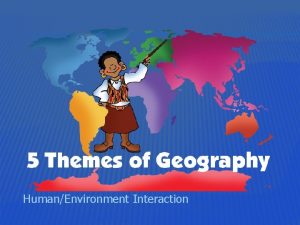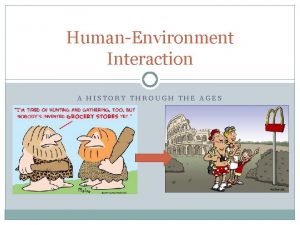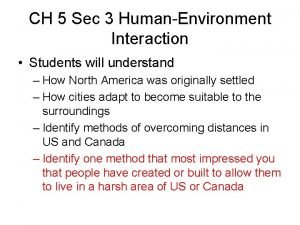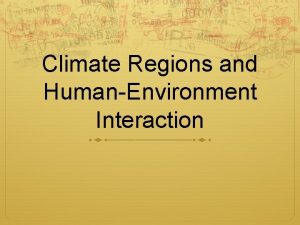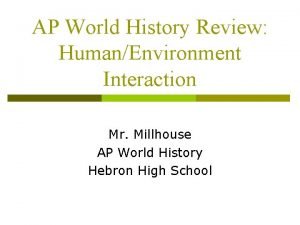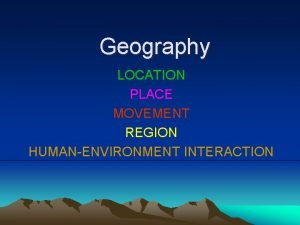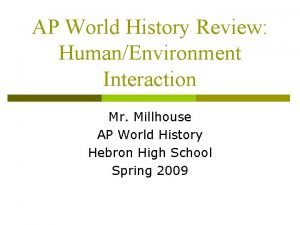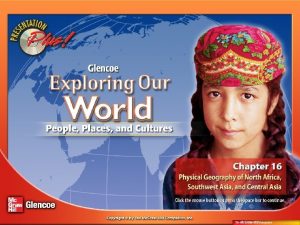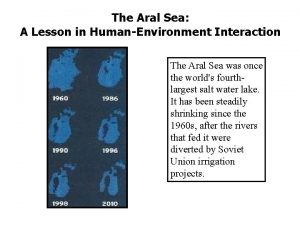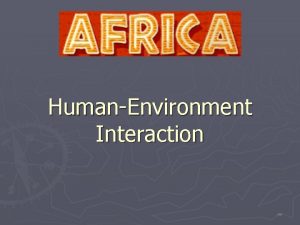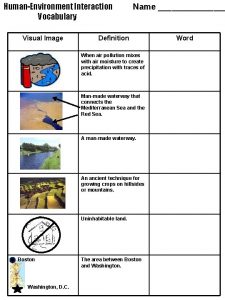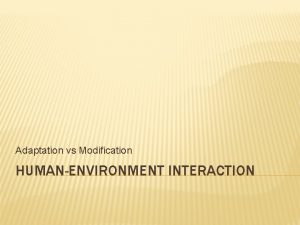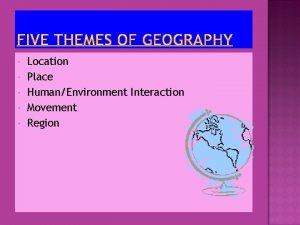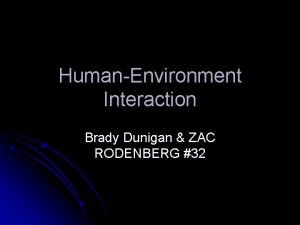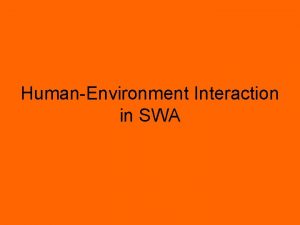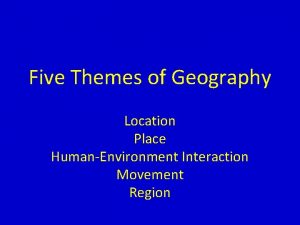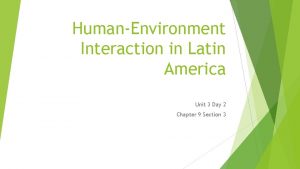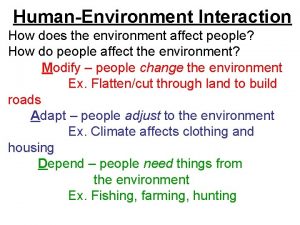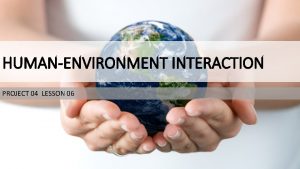HumanEnvironment Interaction Core Concepts 4 Core Concepts 4




































- Slides: 36

Human-Environment Interaction Core Concepts 4

Core Concepts 4. 1 ENVIRONMENT AND RESOURCES

Target • You will be able to recognize the difference between renewable and nonrenewable natural resources • You will be able to explain the importance and future scarcity of energy sources.

Key Terms • • Natural Resource Renewable Resource Nonrenewable Resource Fossil Fuel

Key Terms • Natural Resource – Useful material found in the environment • Renewable Resource – A resource that Earth or people can replace

Key Terms • Nonrenewable Resource – Resource that cannot be replaced in a relativity short period of time • Fossil Fuel – Nonrenewable resource formed over millions of years from the remains of ancient plants and animals

Go Green • What do you or your friends do to go “green” • Why? ? ?

Natural Resource • A useful material found in the environment • Example – Water – Soil – Plants – Animals – Fossil Fuels – Minerals

Renewable vs. Nonrenewable • Renewable – A resource that Earth or people can replace • Example – – Soil Water Plants Animals • Nonrenewable – A resource that cannot be replaced in a relatively short period of time • Example – Fossil Fuels – Minerals

Resource Type Formation Major Issues Soil Renewable Formed from rocks and organic material broken down by natural processes Agricultural Water Renewable Renewed through the water cycle Drinking, agriculture, washing, transportation Plants Renewable Usually grow from seeds; require water and sunlight Food, lumber, clothing, paper Animals Renewable Formed through natural Food, agricultural reproduction; require water and labor, transportation, food clothing Fossil Fuels Nonrenewable Formed over millions of years from plant and animal material Energy, plastics, chemicals Minerals Nonrenewable Formed through a variety of natural and geologic processes Automobile parts, electronics, and many other human made products

Fossil Fuels • Are nonrenewable resources formed over millions of years from the remains plants and animals • When they are used up they are gone • Examples – Coal – Natural gas – Petroleum

Assessment • What do people need from the physical environment? – People need access to essential resources, such as clean water, food, and energy

Assessment • How are renewable and nonrenewable natural resources formed? – Renewable resources are continually produced through physical processes like growth and air circulation. – Nonrenewable resources were originally formed through physical processes, such as decomposition, and can only be replaced very slowly, if at all.

Core Concepts 4. 2 LAND USE

Targets • You will be able to examine the ways in which environment and culture affect land use. • You will be able to investigate how colonization and modern technology have changed the way people use land

Key Terms • Colonization • Industrialization • Suburb

Key Terms • Colonization – Movement of new settlers and their culture to a new area • Industrialization – The development of machine-powered production and manufacturing • Suburb – A residential area on the edge of a city or large town

Colonization • Settlers change regions landscape – Europeans changed America • Brought new farming practices • Cleared areas for cropland • Bring new animals – Cattle – Horses – Hogs

Industrialization • Machines change the environment – Cities built around factories – Machines clear the land for building roads

Industrialization

Suburb

Review • How does land use vary from place to place and over time? – Land use can depend on the environment of a region, such as how suitable a climate is for farming – Land use can also depend on what people living there want and need, such as certain crops.

Review • How have people adapted to and changed the environment? – People have learned to use their physical environment to get any possible resources, such as food through farming and manufactured goods though industrialized areas

Core Concepts 4. 3 PEOPLE’S IMPACT ON THE ENVIRONMENT

Targets • Analyze the link between human activity and environment problems. • Identify ways to reduce people’s harmful impact on the environment.

Key Term • • Deforestation Biodiversity Pollution Spillover

Key Term • Deforestation – The loss of forest cover in a region that results from the trees in a forest being destroyed faster than they can grow back • Biodiversity – Variety of different kinds of living things in a region or ecosystem

Key Term • Pollution – Waste that makes the air, soil, or water less clean • Spillover – An effect on someone or something not involved in a activity

Activity • Write – Food – Water – Clothing – Shelter • Where do these four basic necessities come from?

Extracting Resources • Deforestation – A loss of forest cover in a region • Biodiversity – The variety of living things in a region or ecosystem

Deforestation

Other Impacts • Pollution – Waste that makes the air, soil, or water less clean • Spillover – Which is an effect on someone or something not involved in an activity

Pollution

Spillover


Review • How have new technologies affected people’s ability to change the environment? – Changes in technology have made it easier for people to extract and collect resources • How might future uses of technology affect the Earth? – As technology improves even further, it may allow people to extract even more resources, increasing the rate at which the environment is harmed and resources are used up
 Symbolic interactionism characteristics
Symbolic interactionism characteristics Core concepts of management
Core concepts of management Core concepts of accounting information systems
Core concepts of accounting information systems Core market definition
Core market definition Payroll conference 2014
Payroll conference 2014 A company's resources and capabilities represent
A company's resources and capabilities represent Database basic concepts
Database basic concepts 5 core customer and marketplace concepts
5 core customer and marketplace concepts Core concepts
Core concepts Earth mantle definition
Earth mantle definition Layers of earth from most dense to least dense
Layers of earth from most dense to least dense Purpose of paradox
Purpose of paradox The brittle, rocky outer layer of earth
The brittle, rocky outer layer of earth Area of interaction
Area of interaction Selection by maturation interaction
Selection by maturation interaction Politeness and interaction
Politeness and interaction Dipole induced dipole interaction
Dipole induced dipole interaction A simple interaction design lifecycle model
A simple interaction design lifecycle model What are the five principles that affect learnability
What are the five principles that affect learnability Social interaction in everyday life
Social interaction in everyday life Classroom interaction
Classroom interaction Perceptual regions
Perceptual regions Communication diagrams
Communication diagrams Summation drug interaction
Summation drug interaction Main effect vs interaction
Main effect vs interaction Interaction volume
Interaction volume Logo interaction
Logo interaction Physical interaction design
Physical interaction design Examples of amensalism
Examples of amensalism What are input-output channels in hci
What are input-output channels in hci Hci merupakan
Hci merupakan Immersion interaction imagination
Immersion interaction imagination Human environment interaction
Human environment interaction Serotonn
Serotonn Total physical interaction
Total physical interaction Who is this
Who is this Voice interaction api
Voice interaction api
